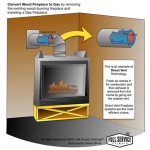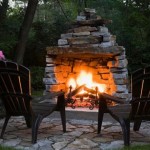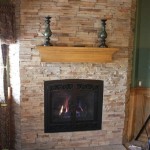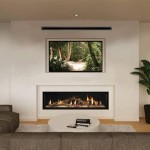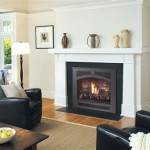Starter Logs for Fireplace: A Comprehensive Guide
A fireplace can be a source of warmth, ambience, and even a focal point in a home. However, building a fire can sometimes be challenging, especially for those inexperienced with traditional methods. Starter logs offer a convenient alternative, designed to ignite quickly and sustain a flame long enough to establish a self-sustaining wood fire.
These manufactured logs are engineered using various materials, primarily wax and compressed wood byproducts, making them a more user-friendly option compared to kindling and traditional firewood. While convenient, it is crucial to understand their composition, usage, and safety considerations to ensure both effective fire starting and responsible fireplace operation.
This guide will provide a detailed overview of starter logs, covering their types, advantages and disadvantages, proper usage, and essential safety precautions. By understanding these aspects, homeowners can make informed decisions about incorporating starter logs into their fireplace practices.
Understanding the Composition of Starter Logs
Starter logs are not simply miniature versions of firewood. Their composition is carefully formulated to promote easy ignition and sustained burning. The primary components typically include:
Wax: Wax, often paraffin wax or a blend of waxes, serves as the primary fuel source. Its low melting point allows for rapid ignition with a match or lighter. The wax saturates the other components, ensuring consistent burning. The type of wax used can affect the log's burn time and the amount of residue produced.
Compressed Wood Byproducts: Materials such as sawdust, wood chips, and other recycled wood products provide the structural matrix for the wax to adhere to. These materials are compressed tightly, creating a dense core that burns steadily. The type of wood used can influence the log's aroma and burn characteristics (although most starter logs are designed to be relatively odorless).
Additives: Some starter logs may contain additives designed to enhance performance. These can include:
- Accelerants: Small amounts of accelerants can further aid in rapid ignition.
- Colorants: Dyes may be added to give the log a specific color. This is purely aesthetic and does not affect performance.
- Aromatics: While less common, some starter logs may contain additives to impart a pleasant scent during burning. However, it is important to note that any scent produced should be mild and not overpowering.
The combination of these elements results in a log that is easy to light, burns consistently, and provides sufficient heat to ignite larger pieces of firewood. The specific proportions of each component can vary between brands, affecting burn time and heat output.
Advantages and Disadvantages of Using Starter Logs
Starter logs offer several compelling benefits, but it is essential to be aware of their potential drawbacks.
Advantages:
Convenience: The primary advantage of starter logs is their ease of use. They eliminate the need to gather kindling and build a traditional pyramid structure. Simply placing one or two logs in the fireplace and lighting them is usually sufficient to start a fire.
Reliability: Starter logs are designed to ignite easily and burn consistently, even in less-than-ideal conditions. This is particularly useful in damp or humid environments where kindling can be difficult to ignite.
Cleanliness: Compared to handling loose kindling and firewood, starter logs are relatively clean. They minimize the amount of debris and dust associated with traditional fire-starting methods.
Predictable Burn Time: Starter logs are manufactured to burn for a specific duration, typically ranging from 30 minutes to a few hours. This allows for better control over the fire-starting process.
Portability: Starter logs are compact and easy to transport, making them suitable for camping or other outdoor activities where building a fire is necessary.
Disadvantages:
Cost: Starter logs are generally more expensive than gathering or purchasing kindling. The convenience they offer comes at a price.
Residue: Burning starter logs can produce more ash and residue than burning only natural wood. This is due to the wax and other additives used in their composition. The fireplace should be cleaned regularly to prevent buildup.
Environmental Concerns: The use of paraffin wax, a petroleum-based product, raises environmental concerns. While some manufacturers are using more sustainable alternatives like plant-based waxes, it is important to consider the environmental impact when choosing starter logs.
Potential Odor: Some starter logs can emit a slight odor when burning, although this is usually minimal. Individuals sensitive to smells should choose unscented options or ensure adequate ventilation.
Not a Substitute for Firewood: Starter logs are designed to initiate a fire, not to sustain it. They should be used in conjunction with firewood for long-lasting heat and ambience.
Proper Usage and Safety Precautions
To maximize the benefits and minimize the risks associated with starter logs, it is crucial to follow proper usage guidelines and adhere to safety precautions.
Placement: Place one or two starter logs in the center of the fireplace grate. Ensure adequate space around the logs for airflow. If using multiple logs, position them slightly apart to allow for even burning.
Lighting: Light the edges of the starter log(s) with a match or lighter. The wax should ignite quickly and spread across the log surface. Avoid holding the flame directly on the log for extended periods, as this can cause uneven burning.
Adding Firewood: Once the starter log is burning steadily, carefully add firewood around and on top of it. Start with smaller pieces of wood and gradually add larger logs as the fire establishes itself. Avoid smothering the starter log with too much firewood at once.
Ventilation: Ensure proper ventilation in the room where the fireplace is located. Open a window or adjust the damper to allow for adequate airflow. This is especially important when using starter logs that contain accelerants.
Never Use Flammable Liquids: Never use gasoline, kerosene, or other flammable liquids to ignite starter logs or firewood. These substances are extremely dangerous and can cause explosions or uncontrolled fires.
Supervision: Never leave a fire unattended, especially when using starter logs. Monitor the fire closely and ensure that it is burning safely and under control.
Carbon Monoxide Detector: Install a carbon monoxide detector in your home and ensure that it is functioning properly. Carbon monoxide is a colorless, odorless gas that can be produced by burning fuels such as wood. It is essential to have a working detector to alert you to the presence of this dangerous gas.
Cleaning: Regularly clean the fireplace and chimney to remove creosote buildup. Creosote is a flammable substance that can accumulate in the chimney and cause a chimney fire. The frequency of cleaning will depend on how often the fireplace is used and the type of wood burned.
Storage: Store starter logs in a cool, dry place away from flammable materials. Keep them out of reach of children and pets.
Disposal: Allow ashes to cool completely before disposing of them. Place the ashes in a metal container with a tight-fitting lid. Never dispose of hot ashes in a plastic container or near flammable materials.
Check Local Regulations: Before using a fireplace or starter logs, check local regulations and ordinances regarding burning restrictions. Some areas may have restrictions on open burning during certain times of the year.
By following these guidelines, homeowners can safely and effectively use starter logs to enjoy the warmth and ambience of a fireplace.
Choosing The Right Starter Log
The market offers a variety of starter logs, each with distinct characteristics. Selecting the right one depends on individual needs and preferences. Considerations should include burn time, environmental impact, and intended usage.
Burn Time: Starter logs come in different burn times, typically ranging from 30 minutes to a couple of hours. Choosing the appropriate burn time is important, as a shorter burn time might not be sufficient to ignite larger firewood, while a longer burn time may be unnecessary and wasteful.
Environmental Impact: As previously mentioned, the environmental impact of starter logs can vary. Opting for logs made with plant-based waxes or recycled wood products reduces the dependence on petroleum-based materials and promotes sustainability. Look for certifications or labels that indicate the log's environmental friendliness.
Scent: While most starter logs are unscented, some offer added fragrances. Ensure the scent will not cause any allergic reactions or discomfort. If you are particularly sensitive to smells, unscented options are recommended.
Indoor vs. Outdoor Use: Some starter logs are specifically designed for indoor or outdoor use. Pay attention to the manufacturer's instructions to ensure the log is suitable for the intended application. Outdoor starter logs may contain additives that are not safe for indoor use.
Brand Reputation: Reading reviews and researching different brands can provide valuable insights into the quality and performance of starter logs. Look for brands with a proven track record and positive customer feedback.
Price: The price of starter logs can vary depending on the brand, composition, and features. Compare prices from different retailers to find the best value for your money. However, prioritize quality and safety over price, as a cheaper log may not perform as well or may pose safety risks.
By carefully considering these factors, homeowners can choose the starter log that best suits their needs and preferences, ensuring a safe and enjoyable fireplace experience.

Duraflame Quick Start 1 125 Lb Firestarter 40 Pack In The Fire Logs Firestarters Department At Com

Pine Mountain Starterlogg Select A Size Firestarting Blocks 24 Starts Firestarter Wood Fire Log For Campfire Fireplace Stove Pit Indoor Outdoor Use Com

Duraflame Firestart Indoor Outdoor Firelighters

Duraflame Firestart Gold Firelighters

Are Artificial Firelogs Any Good Wirecutter

Pine Mountain Traditional 3 Hour Firelogs Long Burning Fire Log 6 Pack Com

How To Build And Start A Fire In Your Fireplace Full Service Chimney

Duraflame 4 5 Lb Gold Premium Fireplace Firelogs With Big Bright Flames

Enviro Log Fire 5 Lb 6 Pack In The Logs Firestarters Department At Com

Pine Mountain Traditional 3 Hour Firelogs Long Burning Firelog For Fireplace Campfire Fire Pit Indoor And Outdoor Use 9 Pack 501 160 805 The Home Depot
Related Posts

